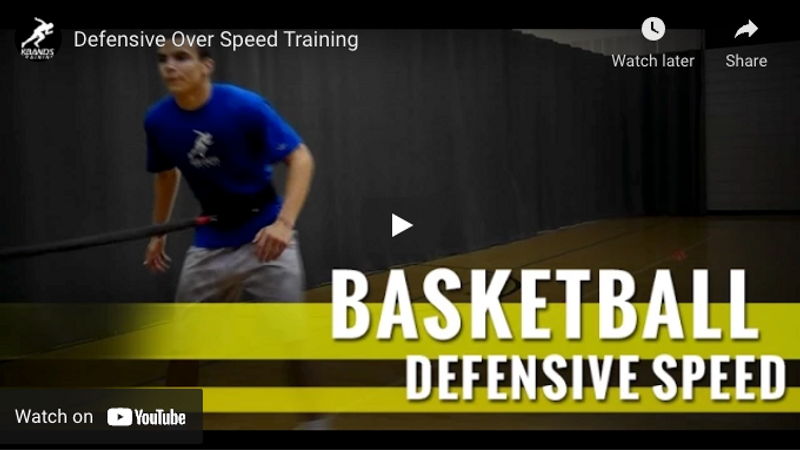Basketball Conditioning Drills | Defensive Overspeed Training Drill
When basketball players create a turnover on the court, they often need to accelerate quickly and move down the court at full sprint in order to stay close to the offensive player who holds possession of the ball. If the defensive athlete can move quickly through the dig phase and maintain top speed during direction changes, then the offensive player can be prevented from moving freely down the court and taking over the momentum of the game.
Executing this maneuver will require development in several key skill areas: First, the defensive player will need to maintain a high level of agility on the turns. This will require fast feet and a low athletic body position. Second, the athlete will need overspeed training in order to accelerate rapidly through the dig phase and into the fastest phase of the sprint. And finally, the athlete will need to develop rapid-fire, explosive strength in the muscle groups of the hips and core. All three of these areas of development will benefit from the use of the Reactive Stretch Cord, and all three will be targeted by the basketball conditioning drill demonstrated in this video, called the defensive overspeed training drill.
Like many of the basketball defense drills in this series, players and coaches can set up and execute this drill in just a few minutes, and the entire exercise can be completed within a short stretch of time. So adding this basketball conditioning drill to a regular seasonal training program will be easy, and will eventually bring excellent results. Basketball defense drills like this one can have a powerful impact on overall team performance.
Basketball Defense Drills: Setting up the Defensive Overspeed Training Drill
This drill, like many of the basketball conditioning drills in the basketball training section of KbandsTraining.com, requires only a set of speed and agility cones and an element of resistance training equipment, in this case the Kbands Reactive Stretch Cord. Both items are available for purchase at KbandsTraining.com.
Four to five cones can be arranged on the court in a zig-zag pattern that follows the motion made by an offensive opponent after a turnover. Meanwhile, the defensive player who will execute the drill will need to attach the Reactive Stretch Cord strap snuggly around the waist and clip the cord to the O ring, which will be positioned at the front of the body.
When the player has warmed up, stretched, and attached the cord, the opposite end will be placed in the hands of an anchoring partner, who will stand at the front of the line of cones and provide flexible resistance. As the drill begins, the athlete should experience the lowest level of resistance in order to gain a feel for the exercise and learn how to maintain the correct body position. The anchoring can step back and increase the resistance level as the athlete becomes more advanced.
It’s also important to keep the most distant cone within 20 feet of the anchoring partner at all times, since this is the maximum safe extension distance for the cord.
Basketball Defense Drills: Executing the Overspeed Training Drill
At the starting signal, the basketball player will move rapidly backwards from each cone to the next, all the while maintaining a low, defensive body position with the arms extended. After reaching the last cone in the lineup, the athlete will break into a straight forward sprint and run straight back up the court toward the anchoring partner. Each rep will begin at the closet cone and end as the player sprints back up the court and takes a very short rest break.
The overspeed defensive drill will provide two essential benefits to the basketball player at the same time: This basketball conditioning drill will help to build speed and core strength during lateral sprints as the athlete moves back and forth from one cone to the next. And the basketball defensive drill will also help develop sprint speed as the player reaches the end and then moves back up the court aided by the pull of the cord.
As the athlete begins the final assisted sprint back up the court, the anchoring partner should be careful to apply the perfect degree of tension—the player should be drawn into overspeed, but the level of resistance should not be high enough to interfere with perfect running technique and form.
Beginning athletes should complete six to eight reps of the drill with very short rest periods, and more advanced athletes can bump the number of reps up to twelve. Rest periods should be just long enough to allow athletes to maintain the same level of explosiveness at each rep of the drill.
Basketball Conditioning Drills: Defensive Overspeed Training Final Notes
Overspeed training and basketball conditioning drills like this one can help athletes develop speed with the Reactive Stretch Cord as long as both the basketball player and the anchor keep a close eye on form and intensity. The athlete’s running form should be perfect, and every rep should involve the same investment of energy and explosiveness.
By accelerating quickly through the dig phase and reaching maximum sprint speed, and maintaining focused reps, basketball players will see steady improvements in speed and an elevated performance during defensive maneuvers on the court.
For more basketball conditioning drills and basketball defensive drills like this one, players and coaches can explore the basketball training section of Kbands Training.com. The site offers a growing library of training demonstrations, tutorials and simple, effective workouts that can help both defensive and offensive players take their game to the next level.

